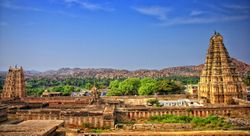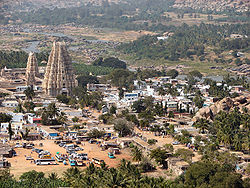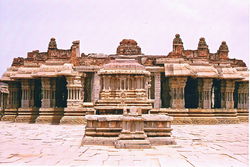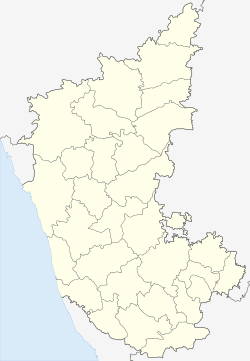Hampi
| Hampi | |
| — town — | |
|
|
|
| Coordinates | |
| Country | |
| State | Karnataka |
| District(s) | bellary |
| Nearest city | hospet |
| Time zone | IST (UTC+5:30) |
| Group of Monuments at Hampi* | |
|---|---|
| UNESCO World Heritage Site | |
 |
|
| State Party | |
| Type | Cultural |
| Criteria | (i)(iii)(iv) |
| Reference | 241 |
| Region** | Asia-Pacific |
| Inscription history | |
| Inscription | 1986 (10th Session) |
| * Name as inscribed on World Heritage List. ** Region as classified by UNESCO. |
|
Hampi (Kannada: ಹಂಪೆ Hampe) is a village in northern Karnataka state, India. It is located within the ruins of Vijayanagara, the former capital of the Vijayanagara Empire. Predating the city of Vijayanagara, it continues to be an important religious centre, housing the Virupaksha Temple, as well as several other monuments belonging to the old city.
As the village is at the original centre of Vijayanagara, it is sometimes confused with the ruined city itself. The ruins are a UNESCO World Heritage Site, listed as the Group of Monuments at Hampi.[1]
Contents |
Etymology
The name is derived from Pampa, which is the old name of the Tungabhadra River on whose banks the city is built. The name "Hampi" is an anglicized version of the Kannada Hampe (derived from Pampa). Over the years, it has also been referred to as Vijayanagara and Virupakshapura (from Virupaksha, the patron deity of the Vijayanagara rulers).
History
Hampi is identified with the historical Kishkindha, the Vanara (monkey) kingdom mentioned in the Ramayana. The first historical settlements in Hampi date back to 1 CE.
Hampi formed one of the cores of the capital of the Vijayanagara Empire from 1336 to 1565, when it was finally laid siege to by the Deccan Muslim confederacy.[1] Hampi was chosen because of its strategic location, bounded by the torrential Tungabhadra river on one side and surrounded by defensible hills on the other three sides.
The site is significant historically and architecturally. The topography abounds with large stones which have been utilized to make larger than life statues of Hindu deities. A structure of historic importance appears every quarter of a mile. The Archaeological Survey of India continues to conduct excavations in the area, to discover additional artifacts and temples.
Geography

Hampi is situated on the banks of the Tungabhadra river. It is 353 km from Bangalore and 74 km away from Bellary. Hosapete (Hospet), 13 km away, is the nearest railway head. The chief languages spoken are Kannada and Telugu. The principal industries of the village are agriculture, the support of the Virupaksha temple and some other local holy places in the vicinity, and tourism. The annual Vijayanagar Festival is organized by the Government of Karnataka in November.
Due to the presence of several mineral deposits in this region (iron-ore, manganese), mining has been going on for many years now. But a recent boom for the supply of iron-ore in the international market has led to excessive mining in this district. The World Heritage Site at Hampi as well as the Tungabhadra Dam are now under threat.
Important sites at and near Hampi

- Achyutaraya Temple/Tiruvengalanatha Temple
- Akka Tangi Gudda
- Anegondi
- Anjeyanadri Hill
- Aqueducts and Canals
- Archaeological Museum at Kamalapura
- Badava Linga
- Chandramauleshwar Temple
- The Kings’ balance
- The Underground Temple
- Tungabhadra River
- Uddana Veerabhadra temple
- Ugra Narasimha
- Virupaksha Temple
- Vittala temple
- Yeduru Basavanna
- Yentrodharaka Anjaneya temple
- Zenana enclosure
- Virupapura
- Madhavan Palace with more than 1,000,000 pillars
- Sasivekalu Ganesha
- Elephant stables
- Lotus temple
Temples
Hampi has various notable Hindu temples, some of which are still active places of worship. Most notable ones are:
- Virupaksha Temple complex: Also known as the Pampapathi temple, it is a Shiva temple situated in the Hampi Bazaar. It predates the founding of the Vijayanagar empire. The temple has a 160-foot (49 m) high tower at its entrance. Apart from Shiva, the temple complex also contains shrines of the Hindu goddesses Bhuvaneshwari and Pampa.
Global Heritage Fund efforts
Global Heritage Fund, in a unique public-private partnership with the Hampi Foundation, Cornell University, and the State of Karnataka, has been actively involved in the conservation of Hampi's unique cultural heritage. Apart from producing a master conservation plan for the site of Chandramauleshwar Temple, the GHF-led effort is now focusing on "the stabilization of the temple and its associated structural features."[2] There is now an installation at the Immigration Museum in Melbourne, Australia about the architecture and archeology of Hampi (until January 2010).[3]
Climbing
Hampi is considered the bouldering capital of India. The extensive rock-hewn landscape and enchanting temple-ruins background provides for a unique climbing experience. Climbers have been visiting this place since 1980s, but it was further given a boost after featuring in a Chris Sharma video.
Scenery

Gallery
 Virupraksha Temple tower |
 Farms as seen from Anjeyanadri Hill |
 Hemakunta complex |
 Lotus Mahal at the Zenana Enclosure |
 Stepped Tank near the Underground Temple |
 Elephant stables |
 The stone chariot at Vittala complex |
 The remains of a giant Bukka's Aqueduct located near Anegondi |
See also
- Vijayanagara
- Vijayanagar Architecture
- Krishna Deva Raya
- Vidyaranya
- Kanakagiri
- Bukka
- Kamalapur
Notes
- ↑ 1.0 1.1 "Group of Monuments at Hampi". World Heritage. http://whc.unesco.org/en/list/241. Retrieved 2006-12-20.
- ↑ Global Heritage Fund - Where We Work - Hampi, India Accessed on 2009-04-24.
- ↑ [1] Accessed ib 2009-06-14.
References
- T.S. Satyan, Hampi: The fabled capital of the Vijayanagara Empire, (Directorate of Archaeology and Museums), Govt. of Karnataka, 1995
- J.M. Fritz et al., New Light on Hampi: Recent Research at Vijayanagara, (Performing Arts Mumbai, 2001) ISBN 81-85026-53-X
- A.N. Longhurst, Hampi Ruins Described and Illustrated, (Laurier Books Ltd., 1998) ISBN 81-206-0159-9
- The Ruins of Hampi:Travel Guide ISBN 81-7525-766-0
Articles and Travelers' experiences
- Magnificent Hampi
- Hampi : Every stone has a story to tell.
- Hampi, and the Saga of the Stones
- Romance on the Rocks… Hampi, Badami, Pattadakal, Aihole.
External links
- Vijayanagara Architecture at Hampi
- Images of Change
- Hampi on UNESCO World Heritage Site
- Global Heritage Fund (GHF) Conserving Hampi's cultural heritage through scientific excellence and community involvement.
- Hampi Maps, Pics, Discussion + more on Global Heritage Network
- Karnataka.com - Hampi
- Hampi travel guide on Wikitravel
- A Guide to History and Tourism at Hampi
- Practical info on traveling to Hampi
- Pictures from Hampe and Anegundi
- 3D virtual views for Hampi siate from UNESCO
- Rock Climbing
- Bouldering
|
|||||||||||||||||||||||||||||
|
|||||||||||||||||||||||
|
|||||


